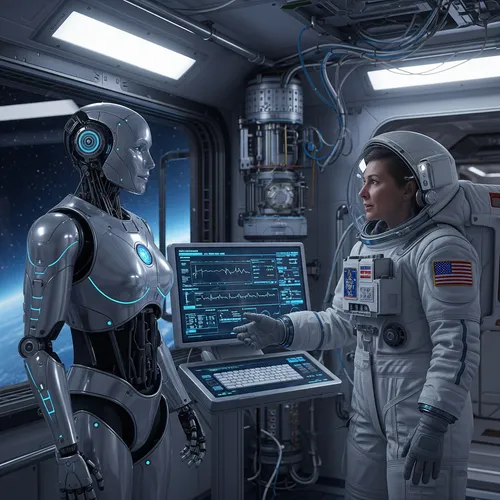Machine Learning & Artificial Intelligence Medical Diagnostic System
Executive Summary
The AI-Driven Medical Diagnosis System for Long-Duration Space Missions (2025–2026) project aims to develop and deploy an autonomous, artificial intelligence (AI)-based medical assistant to support astronaut health and mission safety during Moon and Mars expeditions. As communication delays (4 to 40 minutes) and long communication blackouts make real-time medical support from Earth infeasible, this system will serve as the first line of medical diagnosis and guidance for crews with limited medical training and no on-site physician.
The system will integrate narrow AI (task-specific, rule-based or machine-learned diagnostic modules) and generative AI (large language models capable of nuanced conversation and multimodal reasoning). Running on a robust, single-server partition within the spacecraft’s computing environment, the AI will gather data from biosensors, imaging devices, and crew input, delivering accurate, actionable medical guidance for a range of space-relevant conditions.
By leveraging proven Earth-based medical AI, adapting it for space constraints (power, memory, radiation, and autonomy), and synthesizing real-time data from multiple sources, this initiative will enable timely, effective medical interventions even in complete communication blackout scenarios. This project is crucial for advancing the autonomy of future missions, such as GATEWAY, Axiom, and Starlab, and directly supports NASA’s Moon to Mars strategy.
Project Background
Space Exploration Context:
With NASA, SpaceX, and international partners targeting long-duration lunar and Martian surface missions in the mid-2020s, the health and safety of astronauts are paramount. Unlike aboard the International Space Station (ISS), where near-instant ground support is available, deep space missions face unavoidable communication latency and potential blackouts. Medical emergencies in these extreme environments are compounded by microgravity, radiation exposure, and the lack of advanced hospital facilities.
Challenge:
Astronauts will often have only basic medical or paramedic training. In the event of illness or injury, rapid, accurate diagnosis and intervention can be lifesaving. Traditional telemedicine fails under blackout conditions and is hampered by latency delays. There is thus an urgent need for onboard, autonomous medical decision support systems—intelligent enough to interpret symptoms, analyze physiological data, and provide step-by-step guidance, yet resource-efficient and robust enough for space deployment.
Technological Foundation:
The project builds upon recent advances in:
Narrow AI: Specialized diagnostic algorithms used in hospitals (e.g., sepsis detection, radiology triage).
Generative AI: Large language models (e.g., OpenAI GPT-4, Google Med-PaLM, AMIE) with proven performance in medical question answering and dialog.
Multimodal AI: Systems capable of integrating imaging, sensor data, and natural language to improve diagnostic accuracy.
Mission and Spacecraft Constraints:
Autonomy: The system must operate without external support for up to two weeks.
Reliability: Must withstand the harsh space environment (radiation, limited power, hardware constraints).
User-Centered Design: Interface and recommendations must be accessible to non-experts under stress.
Strategic Importance:
This project directly supports the Moon to Mars initiative, as well as commercial and international space station programs (GATEWAY, Axiom, Starlab), by closing a critical gap in astronaut medical autonomy. It positions the US and its partners at the forefront of AI-enabled crewed space exploration, paving the way for safe, sustainable presence beyond low Earth orbit.
Reference Summary
The text proposes an AI-based system to support medical officers and flight surgeons during long-duration space missions. This system would be pre-trained on Earth's clinical knowledge, then continuously refined in space using data from spacecraft sensors, astronaut health data, and human feedback. The AI would provide personalized health recommendations, adapting to the extreme space environment and operating with low power and bandwidth through edge computing and dimensionality reduction.
The long-term vision requires developing pre-trained models, adapting them to diverse spaceflight data, and integrating them with small, robust processors. A short-term goal is to focus on the data and model software structure. This involves evaluating existing biomedical LLMs (like BioMedLLM, Med-PaLM) for accuracy and selecting the best for a proof-of-concept. Additionally, a synthetic database mimicking various space mission data (environmental, microbial, astronaut physiological) needs to be developed, along with data standardization methods, to refine the chosen LLM. Finally, plausible space mission scenarios with data aberrations should be created to test the model's predictive and recommendation capabilities.

